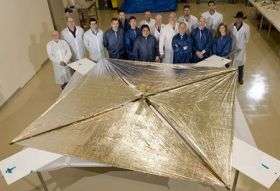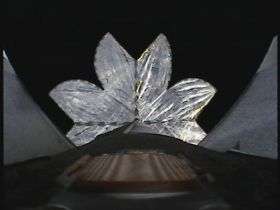A Brief History of Solar Sails

sō’lar sāil, n. - A gossamer material that, when unfurled in the vacuum of space, feels the pressure of sunlight and propelled by said pressure may carry a ship among the stars.
Long ago, someone stood alone on a sandy shore and gazed longingly out at the seemingly endless expanse of ocean, over a horizon suffused softly with ocean mist, musing "I wonder, what's out there?" Then, they fashioned a boat, rigged it with a large cloth to catch the wind, and set sail.
Not quite so long ago, someone stood alone on a sandy shore and gazed longingly up at the seemingly endless expanse of space, suffused softly with sparkling stars, musing "I wonder, what's out there?" Then, they fashioned a spacecraft, rigged it with a large cloth to catch the sun, and set sail.

The first paragraph: Already happened. The second: Any day now….
Two very special missions are planned for the near future; both aim to deploy a solar sail to harness the power of sunlight. NASA's NanoSail-D is a small solar sail slated for launch as early as August 2008. The Planetary Society's Cosmos 2 does not yet have a specific launch target date. Its goal is to make "a controlled flight under sunlight pressure."1
To fully appreciate these two missions, let's travel back in time for a brief history of solar sailing:
Almost 400 years ago, German astronomer Johannes Kepler observed comet tails being blown by what he thought to be a solar "breeze."2 This observation inspired him to suggest that "ships and sails proper for heavenly air should be fashioned" to glide through space.
Little did Kepler know, the best way to propel a solar sail is not by means of solar wind, but rather by the force of sunlight itself. In 1873, James Clerk Maxwell first demonstrated that sunlight exerts a small amount of pressure as photons bounce off a reflective surface. This kind of pressure is the basis of all modern solar sail designs.
In 1960, Echo-1 felt these solar pressure effects loudly and clearly. "Photon pressure played orbital soccer with the Echo-1 thin-film balloon in orbit.... The shards were flung far and wide by sunlight."3
NASA had a more positive experience with solar sailing in 1974 when the Mariner 10 spacecraft ran low on attitude control gas. Because Mariner 10 was on a mission to Mercury, there was plenty of sunlight around and this gave mission controllers an idea: They angled Mariner's solar arrays into the sun and used solar radiation pressure for attitude control. It worked. Though Mariner 10 was not a solar sail mission, and though the radiation pressure it used was incredibly small, this ingenious use of Mariner's solar arrays did demonstrate the principle of solar sailing.
Also in the 1970s, Dr. Louis Friedman, then at NASA's Jet Propulsion Laboratory, led a project to try the first solar sail flight. Halley's Comet was to make its closest approach to Earth in 1986, and NASA conceived the exciting idea of propelling a probe via solar sail to rendezvous with the comet. Eventually, the project was scrapped. Still "the year-long work on preliminary design demonstrated that, indeed, solar sailing was a feasible spacecraft-propulsion technique."4
In 1993, the Russian Space Agency launched a 20-meter diameter, spinning mirror called Znamya 2, hoping to beam solar power back to the ground.
"Some call Znamya 2 a sail because it was made of a large, lightweight reflector and unfurled like a solar sail might be unfurled," says Les Johnson of the NASA Marshall Space Flight Center, co-author of the soon-to-be-published book Solar Sails: A Novel Approach to Interplanetary Travel. "In fact, if I were asked to demonstrate solar sail technology and was constrained to deploy it from a large spacecraft, I might design a 'sail' like Znamya."
The foil reflector unfurled and when illuminated produced a 5 km wide bright spot which crossed Europe from France to Russia at a speed of some 8 km/hr. Unable to control its own flight, however, the mirror burned up in the atmosphere over Canada. Russia's proto-sail program was abandoned in 1999 after a larger, follow-up mission (Znamya 2.5) failed to deploy properly.
Solar sails were an accessory on India's INSAT 2A and 3A communications satellites, circa 1992 and 2003. The satellites were powered by a 4-panel solar array on one side. A solar sail was mounted on the north side of each satellite to offset the torque resulting from solar pressure on the array.
In 2004, the Japanese deployed solar sail materials sub-orbitally from a sounding rocket. Although it was not a demonstration of a free-flying solar sail that could be used for deep-space exploration, the deployment was nevertheless "a valuable milestone" remarks Friedman, who appreciates the challenges of deploying gossamer sheets from fast-moving spacecraft.
To date, no solar sail has been successfully deployed in space as a primary means of propulsion.
The Planetary Society hoped to demonstrate the technology with its Cosmos 1 mission in 2005. "Cosmos 1 was a fully developed solar sail spacecraft intended to fly only under the influence of solar pressure for control of the spacecraft's orbit," says Friedman, now the director of the Planetary Society.
"If all had gone as planned, the US-based Planetary Society, working with Russia, would have been the first to fly a fully functional, though performance-limited, solar sail in space," says Johnson. "It would have been the first spin-stabilized, free-flying solar sail to fly in space."5
Cosmos 1, however, was lost when the launch vehicle failed.
Meanwhile, NASA has also continued to dabble in solar sailing. Between 2001 and 2005, the Agency developed two different 20-meter solar sails (fabricated by ATK Space Systems and L'Garde, Inc., respectively) and tested them on the ground in vacuum conditions. "These sail designs are robust enough for deployment in a one atmosphere, one gravity environment and are scalable to much larger solar sails -- perhaps as much as 150 meters on one side." "A NASA flight test is possible by the year 2010."6
Meanwhile, NanoSail-D is shooting for this summer, and space.
Edward E. Montgomery's team from the Marshall Space Flight Center is working in cooperation with Elwood Agasid's Ames team toward deploying the NanoSail-D solar sail--in fact, "any day now," says Montgomery. It will travel to orbit onboard a SpaceX Falcon 1 rocket, to be launched from Omelek Island in the Pacific Ocean.
"Our primary objective is to demonstrate successful deployment of a lightweight solar sail structure in low Earth orbit," says Montgomery. NanoSail-D will feel two kinds of pressure: (1) aerodynamic drag from the wispy top of Earth’s atmosphere and (2) the pressure of sunlight. Montgomery's team hopes to measure both types of pressure as the sail circles Earth.
Johnson cautions, "If--and it's a big if—they can measure the solar pressure, they will have demonstrated solar pressure as a primary means of orbital maneuvering. They'll have to show conclusively the effects of solar pressure, with a convincingly high signal-to-noise ratio (above the forces resulting from the residual atmospheric pressure)."
Montgomery acknowledges the challenge: "The orbit available to us in this launch opportunity is so low, it may not allow us to stay in orbit long enough for solar pressure effects to accumulate to a measurable degree. We are going to have to look closely at the flight data to see if we can make that determination."
And what of Cosmos 2? The mission is a privately funded project, a partnership of The Planetary Society and Cosmos Studios. Work has begun at the Russian Space Research Institute on some Cosmos 2 spacecraft hardware. They are also studying possible launch configurations on a reliable launch vehicle.7
If successful, NanoSail-D and Cosmos 2 could profoundly affect the future of science and exploration missions.
"Success would be huge for the future of space exploration," says Montgomery.
"Solar sailing is the only means known to achieve practical interstellar flight," says Friedman. "It is our hope that the first solar sail flight will spur the development of solar sail technology so that this dream can be made real."
Each effort is a stepping stone, in the great visionary Carl Sagan's words, along "the shore of the cosmic ocean,"8 leading us closer to sailing among the stars. Future attempts will surely take us the rest of the way.
"'Twas all so pretty a sail it seemed
As if it could not be,
And some folks thought 'twas a dream they'd dreamed
Of sailing that beautiful sea."9
Footnotes:
1,7New developments on the road to Cosmos 2 by Dr. L. Friedman
2Measuring Up to a Solar Sail -- NASA feature story
3Solar-sail mission reflects past and future -- MSNBC
4The History of Solar Sailing by Dr. L. Friedman
5,6From Solar Sails: A Novel Approach to Interplanetary Travel, by Giovanni Vulpetti, Les Johnson (Author), Gregory L. Matloff, to be published in 2008.
8From Cosmos, by Carl Sagan, page 5.
9Excerpt from Winken, Blinken, and Nod, by Eugene Field, 19th century poet.
Link: The basics of solar sailing
Provided by Science@NASA, by Dauna Coulter





















